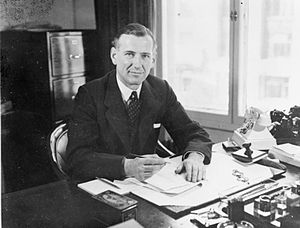Harold Balfour, 1st Baron Balfour of Inchrye
| The Lord Balfour of Inchrye | |
|---|---|

Harold Balfour as Under Secretary of State for Air, at his desk at the Air Ministry, London during the Second World War
|
|
| Born | 1 November 1897 Camberley, Surrey, England |
| Died | 21 September 1988 (aged 90) Shefford, Berkshire, England |
| Allegiance |
|
| Service/branch |
British Army (1914) Royal Flying Corps (1915-18) |
| Years of service | 1914–1917 |
| Rank | Major |
| Unit |
60th Rifles (1914) 60 Squadron (1915-17) No. 43 Squadron (1917) 40 Squadron (1917-1918) 43 Squadron (1918) |
| Battles/wars |
First World War |
| Awards | Military Cross and & Bar |
First World War
Harold Harington Balfour, 1st Baron Balfour of Inchrye, MC*, PC (1 November 1897 – 21 September 1988) was a Conservative Party politician in the United Kingdom, and First World War flying ace. As Under-Secretary of State for Air in 1944 he was instrumental in the establishment of London Heathrow Airport.
Balfour was born in Camberley, Surrey, England on 1 November 1897 and educated at Chilverton Elms School, Dover, Kent and later at the Royal Naval College, Osborne, Isle of Wight.
Balfour joined the 60th Rifles in 1914 and served in France for three months before he transferred to the Royal Flying Corps. After training he was posted to 60 Squadron. In 1917 he was serving with No. 43 Squadron when he downed two enemy aircraft while flying a Sopwith 1½ Strutter. He was injured in a crash and moved on to the School of Special Flying, 40 Squadron, then returned to 43 Squadron. Now piloting the Sopwith Camel he claimed 7 more victories and was promoted to Major. Balfour then took command of a training school until 1919. He was private secretary and Aide-de-camp to Sir John Salmond 1921-22 and temporary ADC to Sir Samuel Hoare, Secretary for Air, 1923. He retired from the Royal Air Force in 1923 to follow a career in journalism and business. Balfour was interviewed on 30 September 1978 by the art historian Anna Malinovska. The interview is reproduced in Voices in Flight (Pen & Sword Books, 2006)
...
Wikipedia
